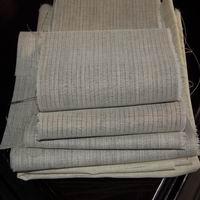French Guard horse forelocks
...a man, small in size and slightly squat;
These squadrons were called the duty squadrons.
the latter shall form in line of battle and port arms
![]()
The Guard Dragoons were defeated in 1807 by the Russians. After battle of Friedland Napoleon sent Guard Dragoons and Saxon cavalry in pursuit of the Russians. They met with a strong force of Russian light cavalry from the rear-guard, were defeated and prsued all the way to the main French army, creating confusion in the ranks of the inntry and artillery. (Elting, Esposito - A Military History and Atlas ...)
- Tauris was a gift from Tsar Alexander of Russia (ext.link) and was ridden in 1812 by Napoleon
The colonels and commanders shall exchange salutes.
In Austerlitz in 1805 they defeated Tsars best cavalry. The Horse Grenadiers advanced from behind inntry clutching their long sabers and shouting, Let the ladies in St. Petersburg to cry! The fight was sharp but short. The Russians were thrown back and pursued until Krenowitz. Russian Guard Cavalry was defeated and only Repnins squadron continued its desperate fight. The surrounded Russians suffered heavy casualties.
austerity and haughty demeanor.
1st Chasseurs-a-Cheval
the horse grenadiers and called for surrender. General Lepic
The Emperor was guarded by a squadron of Guard cavalry, usually of the Chasseurs-a-Cheval (Horse Chasseurs). Only on rare ocassions other troops enjoyed this priviledge. In 1806 when the Guard couldnt catch up with the Emperor, the 1st Hussars escorted him. The Guard was so exhausted on arrival that the hussars continued to escort Napoleon. In the battle of Eckmuhl in 1809 the 1st Chasseurs-a-Cheval (this was line regiment, not guard) escorted the Emperor. Shortly, also in 1809, the 1st Horse Carabiniers enjoyed this priviledge. In 1813 after the battle of Dresden, Napoleon was escorted by the Elite Gendarmes. In most campaigns Napoleon had in his disposal 4 squadrons drawn from the four regiments of Guard cavalry: grenadiers, chasseurs, Polish lancers and dragoons. These squadrons were called the duty squadrons. In the beginning the duty squadrons were one each from the chasseurs and grenadiers, later augmented by the dragoons and Poles, when they became Old Guard. In Leipzig in 1813 the situation was critical and Napoleon was forced to unleash the four duty squadrons (grenadiers, Polish lancers, dragoons and chasseurs). These 800 superb cavalrymen led by Letort scored a brilliant victory against the Austrian horse, including the capture of 190 officers and men of the mous Vincent [Latour] Chevaulegers. (Parquin - Napoleons Victories)
(There were dangers not only on the battlefield. From 1800 to 1805, a terrorist organization led by the Bourbon Comte dArtois and supported by the British Government, attempted no fewer than six times to assassinate Napoleon. The most inmous was the infernal machine (ext.link) which exploded in Paris. This horse-drawn bomb killed many people and demolished a building.) In 1812 the Cossacks attacked Napoleons headquarters at Gorodnia [Horodnia]. The only troops with the Emperor was the Duty Squadron of the Polsih Guard Lancers under Kozietulski. Kozietulskis men threw themselves at the swarm of Cossacks, Kozietulski was pierced by lance which entered his shoulder as r as the bone. It was a dramatic fight. There then appeared the Old Guard Horse Grenadiers in line formation and the Cossacks disappeared into the forest. (In Museum of the Polish Army in Warsaw is exhibited his uniform with the visible hole in the sleeve and stained in blood). The Cossacks returned in large numbers and surrounded the Red Lancers on three sides. The Dutch lost more than 100 men and the Poles lost approx. 20 killed and wounded. Chlapowski of Guard Lancers writes: He [Napoleon] liked to ride downhill at a rapid gallop, regardless of the risk of a broken neck to those following him. He never used spurs nor did he use leg pressure to put the horse into a gallop - he started it with a blow of his whip. According to J.F. Lozier, Napoleon owned approx. 150 horses during the course of his life. Napoleon preferred Arab horses though he often had to make do with other mounts. His horses were schooled by Jardin, who accustomed them to every kind of object. He even went so r as to drive pigs and dogs between their legs. (Georges Blond - La Grande Armee publ. in 1995)
Squadrons of Velites (in Regiment of Horse Grenadiers)
responded: Take a look at these ces and see if they want to
3rd Honor Guards.
... as brave as the Polish lancer, the French lancer had a lively mood;
Art VI - The corps of the vlites with horse will be divided into 8 companies.
Mamelukes
Bessieres was a thorough soldier and all soldier ...
4th Honor Guard - - 5 Not always the best soldiers were sent to the Guard by the colonels of the Line. And this is easy to understand why. In July 1811 Napoleon wrote: Communicate my displeasure to the colonel of the 9th Cuirassiers. He has sent the Guard a bad character who has spent 3 months in jail. Order him to place the responsible parties under 24-hour arrest and publish the ct in his orders. ... The inspectors will select the men for the Guard hereafter. A common criticism of the guard was that it drew off the best men from the line and from the conscripts, thereby robbing them of potential sergeants and corporals. But it must be remembered that Napoleon intended that the guard serves as a training ground for the NCOs from the army so the guard functioned as a military school. For example sergeants of the Old Guard were commisioned as the second lieutenants in the line.
Regiment of Horse Grenadiers
The Polish lancer, as well as the French lancer [Red Lancer] distinguished
a group of 20-30 men rode in front and behind the Emperor.
Lieutenant porte-aigle: La Tartre, Bertrand, Manant, Dalery
2nd Chasseur-a-Cheval
possessing a cold courage that never flinched.
The combination of being calm and intrepid attracted Napoleon. According to Colonel John Elting of US Army, Bessieres was a thorough soldier and all soldier - loyal, brave and even-tempered, possessing a cold courage that never flinched. Bessiers was wounded at the battle of Wagram. Henri Lachoque writes: At this moment Bessieres was needed to charge Liechtensteins cavalry - but the Marshal had just been hit. ... Bessieres was borne unconscious from the field on a litter. His guardsmen thought he was dead and some were sobbing. All swore to avenge him. That was a fine shot, Bessieres the Emperor told him later. It made my Guard cry... Georges Blond described how Bessieres was killed: .... staff surrounded him [Bessieres] and this ciolorful party was spotted by the gunners of an enemy battery. The first round decapitated a sergeant of the Polish light cavalry of the escort. Bessieres, saddened, galloped toward the enemy to inspect their position more closely, then returned: I want this young man buried. Hardly had he spoken, when a round from the same battery struck him fully in the body. Napoleon, learning shortly afterwards of his death, appeared distressed. ... When walking away, he murmured: Death is coming near to us. In Spain Bessieres ordered a reign of terror, seizing hostages and arresting magistrates and priests.
studied to reconcile the severity of behavior with elegance in manners.
- Henri Lachoque
In 1807 at Eylau they stood under hellish fire from 60 Russian cannons, when their commander General Lepic noted some of his troopers ducking incoming shells. Heads up, by God! he cried Those are bullets - not turds. Few moments later they charged and overthrew several Russian units. (Chandler - The Campaigns of Napoleon)
and set off at the gallop back through enemy lines.
4th Honor Guards. . .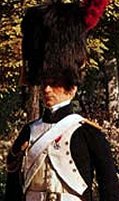
The horse grenadiers shortly campaigned in Spain. Not big battles just a lot of problems with the Spanish guerillas. Henri Lachoque writes: A squadron of horse grenadiers tethered their horses in the garden of a monastery and fell into a trap. Lured by an urchin to come in and quench his thirst, one trooper did not return. A grenadier who went in search of him also disappeared. Some men of their troop returning from a foraging detail conducted an investigation, sabers in hand. They found the child, followed him, and discovered their two comrades with their heads cut off. They arrested 8 monks and threw them all out of the window. (Lachoque - The Anatomy of Glory p 133)
lite Gendarmes
The squadron was given a standard with the inscription Polish Light-Horse, Napoleon Squadron. ~
The Velites were created from conscripts with an income of 300 francs who could produce a pair of buckskin breeches, gauntlets and boots. There were 400 Velites for grenadiers and 400 for chasseurs. The vlites were admitted in the regiments of horse grenadiers and horse chasseurs and formed V and VI Squadrons. Theoretically after 3 or 5 years all the velites became second lieutenants of the line cavalry regiments.
The 20 dragoon regimentsd serving in Spain will each provide 10 men, another 200. The 16 regiments of cuirassiers and carabiniers will each provide 6 men, another 96. As for the 60 men needed to complete the 2nd Lighthorse (Dutch Lancers), the Velites will provide them.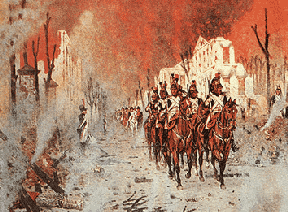
Chirurgien-mjr. and 3 Aide-mjr.
Middle Guard:
- Intendant was a Norman horse mainly used for parades and reviews
The Horse Grenadiers became known for their
- Roitelet was an English-Limousin chestnut, it was ridden
... Just the name of Polish lancer awakes the ideas of bravery
cuirassiers and carabiniers 176 cm tall. In September 1805 was issued decreee:
and no throne without a Guard. But there are guards and Guards.
Lieutenant sous-adjudant-major: Dessofry, Le Roy, Gainde, La Bachellerie
3rd Guard Scouts. 1st Honor Guards.
The Red Lancer:
The dragoons were again defeated on 24th September 1812 by two squadrons of Russian Lifeguard Dragoons. According to Caulaincourt the loss of 150-250 Guard Dragoons caused more consternation in Napoleons headquarters than the loss of 50 generals. (Curtis Cate - The War of The Two Emperors). Lachoque writes from his pro-French perspectice: On the 23rd St.Sulpice was sent to Bezovka, halfway to Mozhaisk, with the Guard Dragoons, two horse batteries, and an inntry regiment to guard the line of communications. Two days later a patrol of 200 dragoons fell into an ambush set up by 4,000 Cossacks ... More than 80 dragoons were killed, wounded, or captured.
3rd (Polish) Lancers 1st Guard Scouts.
and wed have responded with Forward, march !
...His legs are singularly arched,
The horse grenadier (photo from Musee lArme):
- Styrie was ridden by Bonaparte at Marengo.
from chasseurs and dragoons 173 cm, and candidates from
![]()
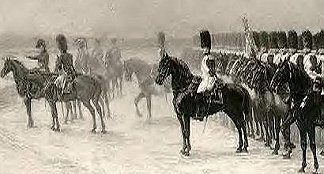
Squadrons of Velites (in Regiment of Polish Lancers)
The Horse Grenadiers of Old Guard (nicknamed The Giants, and The Gods) and the Polish Guard Lancers were the only two cavalry regiments of Napoleons Guard never defeated by enemys cavalry in combat. The other regiments suffered only few setbacks during the many years of campaigning. In almost each case they were outnumbered by the enemy.
The Guard was no more.
artillery battery (100 gunners of Old Guard) A squadron of Polish lancers under Chef dEscadron Jerzmanowski and Major Roul - 125 men divided into a mounted company of 22 under Capitaine Schultz (a giant over 2.13 metres who was present at Waterloo); a dismounted company of 96 under Capitaine Balinski... There was also a group of 7 chasseurs and Mamelukes commanded by Lieutenant Seraphin (a Mameluke...) The lancers had a white standard emblazoned in crimson with the words, Polish Light-Horse, Napoleon Squadron with a crowned N on the reverse. (Mark Adkin - The Waterloo Companion p 14)
Dragoons Light Cavalry
An old adage runs: There is no temple without a God
operation which he bore with great courage, the man called out
with him to Saint-Helena. It now resides - stuffed - in the Muse de lArme in Paris. (ext.link) Napoleon was never the best of horsemen, and most often travelled by coach. It was painted in green, drawn by 6 large grey horses (three ex-drivers of Guard Horse Artillery rode on them), and had 2 coachmen on top and a servant on the box. The coach contained pull-out bed, hand-operated printing press, his mobile treasury, and small library. The escort of the coach was as follow: four Guard Chasseurs-a-Cheval rode in pairs before the coach, and twelve pairs were behind it. At night 5 lamps illuminated the coach, which gave extraordinary appearance as it raced through villages.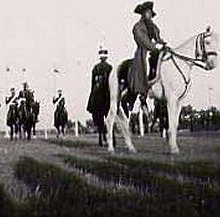
Staff:
~
(Regiment de Dragons de la Garde Impriale). In 1807 fourth unit was raised, the Polish Guard Lighthorse
in Napoleons genius: We could have been asked to conquer the moon,
Heavy Cavalry
... it was he who ensured respect ...
In 1800 at Marengo the Horse Grenadiers waited calmly under fire. Keep your chins up ! shouted their sergeants. Moments later they drew their sabers and charged overthrowing everything on their way.
Art. II - This corps will be composed of conscripts from the 3 last years, at a rate of 6 per Department, taken among those who come forward voluntarily, or, iling this, indicated by the prefect.
Ten patrols of horse grenadies guarded the inside of the Kremlin.
or simply The High Heels (from their tall boots).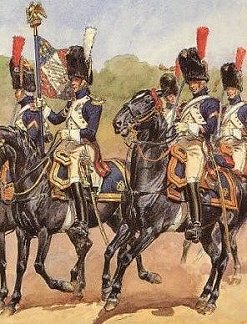
Capitaine adjudant-majors: Scribe, Lepot
In 1814 a major of Horse Grenadiers was wounded at Craonne.
The Polish lancer:
the surgeon had to amputate his leg. During the extremely painful
Gendarmes
2nd Guard Scouts.
Lieutenant a la suite: Desiles, Tabary, Leleu
... could be confused with the horse grenadier;
In 1812 the 3rd Guard Lancers (Young Guard, Polish) was defeated in 1812 at Slonim by a large number of Chaplitzs Cossacks and Russian Pavlograd Hussars. General Konopka, 13 officers, and 253 men were captured.
because of his graceful nature during such ceremonies.
Art. XII - Those of the vlites who are distinguished by their control, their aptitude and their behavior, could be allowed in the Imperial Guard before having reached the age and the number of years of service required to belong to the aforementioned Guard.
The elite gendarme:
at Smolensk, Borodino, during his entrance in Moscow, and during the retreat from Russia.
![]()
The dragoon:
Art. I - A corps of horse vlites will be formed with 800 men.
Regiment of 1st Lancers (Polish)
Among the four duty squadrons the Chasseurs had a special task:
...an enormous moustache decks his upper lip;
and one of the Napoleons vorites. In 1815 Napoleon brought it
in his ears silver rings are hanging ... intrepid ...
and the colors of his origin moderated, in respect to the military roughness
His skeleton is kept at the National Army Museum in London. (ext.link)
In 1806 was formed third regiment, the Guard Dragoons -->
the other riders of the army. He was of tall stature ...
Colonel-commandant: General de Division Walter
Young Guard:
Regiment of Horse Chasseurs
These men will be taken from the regimental depots, and if enough men of the required quality are not available at the depots, then the shortll will be made up from the combat squadrons in Spain.
In 1814 being brought to Elba, and in 1815 it was ridden from Golf-Juan to Paris.
of the first figure.
Among the four duty squadrons the Guard Chasseurs had a special task: a group of 20-30 men rode in front and behind the Emperor, while a corporal and 4 chasseurs cleared a way for him. One of the four carried his despatch case and another his field glass. If the Emperor dismounted these men would immediately do likewise.
Picture: Guard Dragoons and Napoleon in burning Moscow, 1812. Some time before the campaign in 1812 in Russia the Guard was ranked into three categories: Old, Middle and Young Guard. The Old Guard enjoyed the highest prestige, in 1811 Napoleon made it clear to Berthier (chief-of-staff) I wish it clearly understood that this priviledge doesnt apply to the 2nd Grenadiers and 2nd Chasseurs, nor to the Fusiliers (Middle Guard), voltigeurs and tirailleurs (Young Guard) nor the 2nd Lighthorse-lancers (Red Lancers). ... Keep this decision for your guidance alone. Old Guard:
Capitaine adjudant-de admin.: Varnout, Messager
he was more sober especially in his way of living,
The cavalry of the Imperial Guard was commanded by Marshal Jean-Baptiste Bessieres (1766-1813). He was a tall man, always impeccably uniformed and rigorous in discipline. Bessieres was one of the Good Marshals, like by soldiers. He alone kept the old-shioned military style of both powdering his hair and wearing it in a long queue.
![]()
2nd Red Lancers
The chasseur:
(Regiment de Chevau-Lgers de la Garde Impriale Polonais). In 1807 it was ordered that all cavalry regiments will send approx. 700 bravest soldiers who had distinguished in battles regardless of their length of service. In 1810 fifth regiment was formed, the Dutch lancers.
in 1813 at Ltzen and in 1814 at Arcis-sur-Aube.
The Horse Grenadiers participated in several battles and many small combats. Below is a list of their most known exploits.
Regiment of 2nd Lancers (Red Lancers, Dutch)
In 1812 the horse grenadiers were in Russia. Chlapowski writes: There then appeared the Horse Grenadiers, in line formation. This line of black horses, its tall riders also in black bearskins, so impressed the Cossacks that they disappeared into the forest. (Chlapowski, - p 123)
- Vizir it was a gift from the Sultan of Turkey (ext.link) in 1805
[Regiment de Grenadiers--Cheval de la Garde Impriale]
The Guard Chasseurs (Chasseurs-a-Cheval de la Garde) were defeated in December 1808 at Benavente by British and German cavalry (3rd Kings German Legion Dragoons, and British 10th Hussars and 18th Light Dragoons). The chasseurs lost 127 men, and their commander, Lefebvre-Desnouettes, was captured by a German named Bergmann, who gave up his prize to British hussar Grisdale.
![]()
but with the quickness of his movements, with his instinctive exuberance,
of Guard cavalry: Horse Grenadiers, Chasseurs, Dragoons and Polish lancers.
Napoleon had in his disposal 4 squadrons drawn from the four regiments
![]()
Mamelukes. 1st (Polish) Lancers
himself by his elegant appearance; but the looks of this last were softer
In the squadrons of Velites (Young Guard) only privates were the raw recruits, the real Young Guard. All officers were veterans of Old Guard. The NCOs were of Middle Guard. In 1813 Napoleon ordered that every cavalry regiment in Spain will send 20 best veterans into the Old Guard. The squadrons of Young Guard were made up of true volunteers from the towns and departments near Paris. These volunteers were not those who went into the Honor Guards. (Bowden - Napoleons Grande Armee 1813 p 39)
In the very end of the battle of Waterloo, when the entire French army fell apart before the Prussians and British-Netherland army, the horse grenadiers made a great impression on the pursuers. Cpt. Barton of the 12th Light Dragoons described how his regiment advanced against the giants on black horses. The grenadiers appeared to take but little notice of our advance, when opposite their flank they fired a few pistol or carbine shots. We were ... being too weak to make an impression [on them], they literally walked from the field in a most majestic manner. In November 1815 the regiment was disbanded. On 25 November for the last time their trumpeters sounded the Ban. The standard-bearer advanced to the Inspector and presented the standard. It was the last unit of the whole Imperial Guard (inntry, cavalry, and artillery) disbanded by the Bourbons.
2nd Honor Guards.
one recognized that which one so precisely called the French of North. ...
Chefs de Escadron: Hardy, Morin, Veniere, Pernet, Delaporte, Jimcker
Art. III - Among the 6 vlites provided by each department, three must be 5 4 tall, and three 55 tall and above. Art. IV- The vlites will have to be well to do and to have, by themselves or their parents, an assured income 300 francs per annum.
- Marengo was one of the horses ridden at Waterloo.
... more slender in his physical form [than horse grenadier]. He was
In 1812 the 2nd Guard Lancers (Middle Guard, Dutch Red Lancers) were harrased mercilessly by Ataman Platovs Cossacks and suffered heavy losses. The Cossacks and their methods of combat were unknown to the Dutch. Only very few survived this campaign.
or present sabers ... Flags and standards shall be dipped,
List of names of some of his horses include: Austerlitz, Artaxercs, Babylonien, Cid, Conqurant, Extrme, Euphrate, Kurde, Montevideo, Sheikh, Sahara, Triomphant, Tamerlan.
and of military fidelity ! ... all made him at first taken for German;
He had his foot carried away by a Russian cannonball and
The general expression of his figure was the coldness.
In 1814 the Russian, Prussian, and Austrian armies entered France and after several battles reached the gates of Paris. Napoleon abdicated on April 6. However, occasional military actions continued in Italy, Spain, and Holland throughout the spring of 1814. On April 7th Napoleon called for volunteers from his Old Guard to serve in his guard on Elba Island. The Allies allowed for 500 inntrymen, 120 cavalrymen and 120 artillerymen. Generals Petit and Pelet were soon swamped with requests. Many officers asked to serve as privates. Out of the French and Polish cavalry only 100 Polish lancers were chosen. There were additionally several hundred volunteers from inntry, 300 grenadiers and 300 chasseurs of Old Guard. These men were his escort, his protectors in thisvery difficult and sad time. Charles Parquin writes: General Krasinski who commanded the Polish lancers ... came forward with his officers. As he took his leave of the Emperor he uttered these words, which do the greatest credit to his nation: Sire, if you had mounted the throne of Poland, you would have been killed upon it; but the Poles would have died at your feet to a man. Krasinki wearing his parade uniform announced to his lancers that God has visited misfortune upon the Emperor and all began to weep. They regreted they had not all been killed before hearing that anyone had dared demand Napoleons abdication. Loud cries for vengeance were heard along with Vive lEmpereur! Sabers and lances were brandished and the cavalry moved toward Fontainebleau. They passed through Nainville before Sebastianis ADC halted them. Troops on Elba Island:
Squadrons of Velites (in Regiment of Horse Chasseurs)
In 1796 the Guard of the Directory was formed to escort the Directors in public ceremonies and parades. These guardsmen were 510 tall, literate, with perfect conduct and participated in at least 2 campaigns. These men were the elite of the army and formed 2 companies of foot grenadiers and one squadron of horse grenadiers. The horse grenadiers wore aiguillette on the right shoulder. It was the distinctive insignia of Guard cavalry. The Guard drew extra pay and allowances, additionally they got better housing and enjoyed the highest prestige. The guardsmen were forbidden, under pain of dismissal, to tend an officers horse, or even hold it by the bridle.
Horse Grenadiers
surrender ! Then he shouted to the grenadiers Follow me !
Squadrons of Velites (in Regiment of Dragoons)
Regiment of Dragons
... steadiness that distinguished it among all
1 In 1802 Napoleon submitted a permanent schedule of recruitment: 2 men from each cavalry regiment, tall, robust, of exemplary conduct, able to read and write and who participated in at least 3 campaigns. In 1806 each cavalry regiment was ordered to send 6 best men to the Guard.
Rousselot writes: The picket that accompanied Napoleon during his frequent excursions away from his field Headquarters was drawn from the Chasseur service squadron and comprised a lieutenant, a marechal-des-logis, two brigadiers, a trumpeter and 22 chasseurs, some riding in advance and some to the rear of the group immediately surrounding the Emperor. The latter included a brigadier and 4 chasseurs, one of whom carried Napoleons portfolio containing his maps, writing materials and dividers, while another bore his telescope.
- Dsire was one of the horses ridden at Waterloo.
Vive lEmpereur! and lost consciousness. When it came to muscle and physique, the grenadiers, man for man, could have thrown the chasseurs, Mamelukes, and the Young Guard, all outdoors and walked on them. The horse grenadiers were strong, tall and handsome, and their colonel forbade any woman under 40 to come in and make soup for them. :-) For new candidates there were strict requirements: 176 cm tall, 10 years service, minimum 4 campaigns and citation for bravery. The legionaires were exempted from all requirements. Most candidates came
while the intemperance of Polish had become proverbial in the army.
Quartier-maitre tresorier: Chef de Escadron Perrot
His death in battle made my Guard cry - told Napoleon.
Majors: General de Brigade Laferriere and Castex
The candidates from the hussars were at least 170 cm tall,
Picture: Eagle-Bearer of Horse Grenadiers [Grenadiers-a-cheval de la Garde] in parade uniforms, by Rousellot. For parade their horses were decorated with red, braided forelocks and crupper rosettes. The Horse Grenadiers were the senior regiment in the Guard and the Army. Their priviledged position the whole army - and even the Guard - had envied. Below is a short history of this splendid unit. In 1796 the Guard of Directory (Garde du Directoire) was organized and one squadron of Horse Grenadiers was raised. Soon Napoleon enlarged the troop to two and then to four squadrons. The privates wore dark blue coats and collars, white lapels and tall boots. In 1797 they received tall fur caps. In 1804 the Consular Guard became Imperial Guard. The troopers were quartered at the barracks in the Ecole Militaire where they slept in solid oak beds 68 by 4 with a shelf at the head. The food was good and the wine even better. The regiment usually had four large squadrons and 1-2 squadrons of so-called velites. In 1813 (Leipzig Campaign) the regiment consisted of 6 squadrons and enlarged staff. See below:
(2e Regiment de Chevau-Lgers Lanciers de la Garde Impriale). In December 1811 Napoleon wrote to his Chief-of-Staff Marshal Bessieres: I see that thanks to your efforts the cavalry strength of Guard amounts to 6.450, or 400 men short of establishement. I have decreed that the following regiments shall each provide 10 men of the required quality, to wit the 1st, 2nd, 3rd, 4th and 10th Hussars, and the 10th, 13th, 14th, 15th, 22nd, 26th, 27th, 29th and 30th Chasseurs, totalling 140 men.
0.5 - Each squadron had 2 companies. Each company had: 1 Capitaine, 2 Lieutenant en premier, 2 Lieutenant en second, 1 Marechal-des-logis-chef, 6 Marechaux-logis, 1 Fourrier, 10 Brigadiers, 3 Trompettes, 1 Marechal-ferrant (blacksmith), 96 Privates. (In 1813 each company had 4 Marechaux-logis instead of 6, and 8 Brigadiers instead of ten.)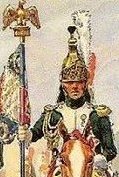
The army nicknamed them The Giants, The Gods
The squadrons of Young Guard were routed in Leipzig in 1813 by Chaplitzs Russian uhlans and dragoons.





